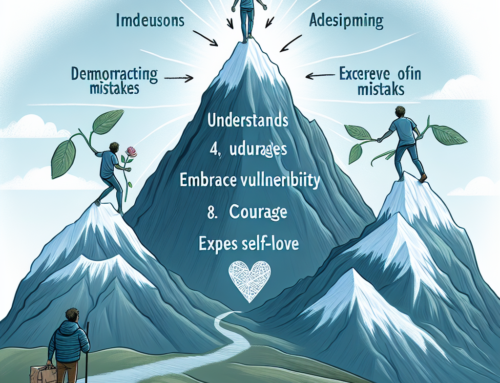
Understanding Vulnerability in Team Dynamics
Understanding vulnerability in team dynamics is a crucial aspect of building resilient teams, and Brené Brown’s insights offer invaluable guidance in this area. Brown, a research professor and author renowned for her work on vulnerability, courage, and empathy, emphasizes that vulnerability is not a weakness but a strength that can foster deeper connections and trust within teams. By embracing vulnerability, team members can create an environment where everyone feels safe to express their ideas, take risks, and support one another through challenges.
One of the key points Brown makes is that vulnerability is the birthplace of innovation, creativity, and change. When team members are willing to be vulnerable, they are more likely to share their unique perspectives and ideas, which can lead to innovative solutions and breakthroughs. This openness encourages a culture of collaboration, where individuals feel valued and heard. As a result, teams become more adaptable and better equipped to navigate the complexities of their work.
Moreover, vulnerability plays a significant role in building trust, which is the foundation of any resilient team. Trust is established when team members are transparent about their thoughts and feelings, and when they show empathy and understanding towards one another. Brown’s research highlights that trust is built in small moments, through consistent actions that demonstrate reliability, integrity, and care. By fostering an environment where vulnerability is welcomed, teams can strengthen their trust and cohesion, making them more resilient in the face of adversity.
In addition to trust, vulnerability also enhances emotional intelligence within teams. Emotional intelligence involves recognizing and managing one’s own emotions, as well as understanding and influencing the emotions of others. When team members are open about their vulnerabilities, they become more attuned to their own emotional states and those of their colleagues. This heightened emotional awareness can lead to more effective communication, conflict resolution, and overall team harmony. Brown’s work underscores the importance of creating a space where emotions are acknowledged and respected, as this can significantly impact team dynamics and performance.
Furthermore, embracing vulnerability can help teams navigate failure and setbacks more effectively. Brown points out that failure is an inevitable part of any endeavor, and how teams respond to it can determine their resilience. When team members feel safe to admit their mistakes and learn from them, they can collectively grow and improve. This approach fosters a growth mindset, where challenges are seen as opportunities for development rather than threats. By normalizing vulnerability and reframing failure as a learning experience, teams can build the resilience needed to persevere through difficult times.
To cultivate vulnerability within teams, leaders play a crucial role. Brown emphasizes that leaders must model vulnerability by being open about their own challenges and uncertainties. When leaders demonstrate vulnerability, they set the tone for the rest of the team, encouraging others to do the same. Additionally, leaders can create structures and practices that support vulnerability, such as regular check-ins, open forums for feedback, and team-building activities that promote trust and connection.
In conclusion, understanding vulnerability in team dynamics is essential for building resilient teams. Brené Brown’s insights highlight the power of vulnerability in fostering innovation, trust, emotional intelligence, and resilience. By embracing vulnerability, teams can create a supportive and collaborative environment where everyone feels empowered to contribute their best. As teams navigate the complexities of their work, the strength derived from vulnerability can be a key factor in their success and sustainability.
The Role of Empathy in Strengthening Team Bonds
Empathy, often described as the ability to understand and share the feelings of another, plays a crucial role in building resilient teams. According to Brené Brown, a renowned researcher and storyteller, empathy is not just a soft skill but a powerful tool that can transform team dynamics and foster a culture of connection and trust. When team members feel understood and valued, they are more likely to collaborate effectively, support one another, and navigate challenges with greater resilience.
One of the key aspects of empathy in a team setting is active listening. This involves not just hearing the words that are spoken but truly understanding the emotions and intentions behind them. When team members practice active listening, they demonstrate that they care about each other’s perspectives and experiences. This, in turn, creates an environment where individuals feel safe to express their thoughts and feelings without fear of judgment or dismissal. As a result, team members are more likely to share innovative ideas, voice concerns, and contribute to problem-solving efforts.
Moreover, empathy helps to bridge the gap between diverse team members. In today’s globalized world, teams often consist of individuals from various cultural backgrounds, each bringing unique viewpoints and experiences to the table. By practicing empathy, team members can appreciate these differences and find common ground. This not only enhances mutual respect but also enriches the team’s collective intelligence, leading to more creative and effective solutions.
Empathy also plays a vital role in conflict resolution. Disagreements and misunderstandings are inevitable in any team, but how they are handled can make all the difference. When team members approach conflicts with empathy, they are more likely to seek to understand the other person’s perspective and find a resolution that respects everyone’s needs and concerns. This approach not only resolves the immediate issue but also strengthens the team’s overall cohesion and trust.
Furthermore, empathy fosters a sense of belonging and inclusion within the team. When individuals feel that their emotions and experiences are acknowledged and valued, they are more likely to feel a sense of belonging. This is particularly important for team members who may feel marginalized or excluded. By creating an empathetic environment, leaders can ensure that all team members feel included and valued, which boosts morale and engagement.
Brené Brown emphasizes that empathy is not about fixing someone’s problems or offering unsolicited advice. Instead, it is about being present and showing genuine concern for another person’s well-being. This can be as simple as acknowledging someone’s feelings, offering a listening ear, or expressing understanding and support. These small acts of empathy can have a profound impact on team dynamics and individual well-being.
In addition, empathy can enhance leadership effectiveness. Leaders who demonstrate empathy are more likely to build strong relationships with their team members, earn their trust, and inspire loyalty. Empathetic leaders are also better equipped to understand and address the needs and concerns of their team, which can lead to higher levels of satisfaction and performance.
In conclusion, empathy is a powerful tool for building resilient teams. By fostering a culture of understanding, respect, and support, empathy strengthens team bonds and enhances overall performance. As Brené Brown’s research highlights, empathy is not just a nice-to-have quality but a critical component of effective teamwork and leadership. By prioritizing empathy, teams can navigate challenges with greater resilience and achieve their collective goals.
Building Trust Through Authentic Leadership
Brené Brown’s Guide to Building Resilient Teams emphasizes the importance of building trust through authentic leadership. In her extensive research on vulnerability, courage, and empathy, Brown has discovered that trust is the cornerstone of any resilient team. Without trust, teams struggle to communicate effectively, collaborate efficiently, and innovate creatively. Therefore, fostering an environment where trust can flourish is essential for leaders who aim to build resilient teams.
One of the key elements in building trust is authenticity. Authentic leadership involves being genuine and transparent with your team members. This means sharing your thoughts, feelings, and experiences openly, and encouraging others to do the same. When leaders are authentic, they create a safe space where team members feel comfortable being themselves. This, in turn, fosters a sense of belonging and connection, which is crucial for building trust.
Moreover, authentic leaders are not afraid to show vulnerability. According to Brown, vulnerability is not a sign of weakness, but rather a sign of courage. When leaders are willing to be vulnerable, they demonstrate that it is okay to take risks and make mistakes. This encourages team members to step out of their comfort zones and take on new challenges, knowing that they have the support of their leader and their team. By embracing vulnerability, leaders can build a culture of trust and resilience within their teams.
In addition to authenticity and vulnerability, empathy plays a crucial role in building trust. Empathy involves understanding and sharing the feelings of others. When leaders practice empathy, they show their team members that they care about their well-being and are willing to support them through difficult times. This creates a sense of psychological safety, which is essential for building trust. Team members who feel understood and supported are more likely to be open and honest with their leaders, which strengthens the overall trust within the team.
Furthermore, effective communication is vital for building trust through authentic leadership. Leaders must be clear and consistent in their communication, and they must also be good listeners. By actively listening to their team members, leaders can gain valuable insights into their needs, concerns, and aspirations. This allows leaders to address any issues promptly and effectively, which helps to build trust. Additionally, open and honest communication fosters transparency, which is another key component of trust.
Another important aspect of building trust is accountability. Leaders must hold themselves and their team members accountable for their actions. This means setting clear expectations, providing regular feedback, and addressing any issues that arise. When leaders hold themselves accountable, they demonstrate integrity and reliability, which builds trust. Similarly, when team members are held accountable, they learn to trust each other and work together more effectively.
Lastly, building trust through authentic leadership requires a commitment to continuous learning and growth. Leaders must be willing to reflect on their own behavior and make necessary changes to improve their leadership skills. This involves seeking feedback from their team members and being open to constructive criticism. By demonstrating a commitment to personal and professional growth, leaders can inspire their team members to do the same, which fosters a culture of trust and resilience.
In conclusion, Brené Brown’s Guide to Building Resilient Teams highlights the importance of building trust through authentic leadership. By being genuine, embracing vulnerability, practicing empathy, communicating effectively, holding themselves and their team members accountable, and committing to continuous learning, leaders can create an environment where trust can thrive. This, in turn, leads to stronger, more resilient teams that are better equipped to navigate challenges and achieve success.
Strategies for Fostering a Culture of Courage
Building resilient teams is a cornerstone of organizational success, and few people understand this better than Brené Brown. Her extensive research on vulnerability, courage, and leadership provides invaluable insights into fostering a culture where teams can thrive. One of the key strategies she advocates for is creating an environment where team members feel safe to express themselves openly. This involves encouraging vulnerability, which might seem counterintuitive in a professional setting but is essential for building trust and fostering genuine connections.
To begin with, leaders must model the behavior they wish to see in their teams. When leaders are open about their own vulnerabilities, it sets a powerful example. This doesn’t mean oversharing personal details but rather being honest about uncertainties and challenges. For instance, admitting when you don’t have all the answers can create a space where team members feel comfortable doing the same. This authenticity can break down barriers and build a foundation of trust, which is crucial for resilience.
Moreover, fostering a culture of courage involves encouraging risk-taking and innovation. Teams that are afraid of failure are less likely to take the bold steps necessary for growth and improvement. Brené Brown emphasizes the importance of reframing failure as a learning opportunity rather than a setback. By celebrating efforts and learning from mistakes, leaders can create an atmosphere where team members are not paralyzed by the fear of making errors. This shift in perspective can lead to increased creativity and a willingness to tackle challenges head-on.
Another critical aspect is the practice of empathy. Understanding and acknowledging the emotions and perspectives of team members can significantly enhance team cohesion. Brené Brown suggests that empathy is not about fixing problems but about connecting with others on an emotional level. When team members feel heard and understood, they are more likely to support each other and work collaboratively. This sense of belonging can be a powerful motivator and a key component of a resilient team.
In addition to empathy, clear and open communication is vital. Teams need to have honest conversations about their goals, expectations, and any obstacles they might face. Regular check-ins and feedback sessions can help keep everyone aligned and address any issues before they escalate. Brené Brown advocates for ”rumbling with vulnerability,” which means having tough conversations with courage and compassion. These discussions can lead to deeper understanding and stronger relationships within the team.
Furthermore, recognizing and celebrating achievements, no matter how small, can boost morale and reinforce a positive team culture. Acknowledging the hard work and contributions of team members can make them feel valued and appreciated. This recognition can be a powerful motivator and can help build a sense of pride and ownership in the team’s collective success.
Lastly, fostering a culture of courage requires a commitment to continuous learning and development. Encouraging team members to pursue professional growth opportunities and providing the necessary resources can help them build new skills and stay engaged. Brené Brown highlights the importance of creating an environment where learning is valued and supported. This not only enhances individual capabilities but also strengthens the team as a whole.
In conclusion, Brené Brown’s strategies for fostering a culture of courage revolve around creating an environment of trust, empathy, open communication, and continuous learning. By embracing vulnerability, encouraging risk-taking, and celebrating achievements, leaders can build resilient teams capable of navigating challenges and achieving success.
The Impact of Clear Communication on Team Resilience
In the realm of team dynamics, the importance of clear communication cannot be overstated. Brené Brown, a renowned researcher and storyteller, has extensively explored the elements that contribute to building resilient teams. One of the key factors she emphasizes is the impact of clear communication. When team members communicate effectively, they create an environment where trust, understanding, and collaboration can flourish, ultimately leading to greater resilience.
Clear communication serves as the foundation for trust within a team. When individuals feel heard and understood, they are more likely to trust their colleagues and leaders. This trust is crucial, especially during challenging times, as it allows team members to rely on one another and work together to overcome obstacles. For instance, when a team faces a tight deadline or a complex project, clear communication ensures that everyone is on the same page, reducing misunderstandings and fostering a sense of unity.
Moreover, clear communication helps in setting expectations and defining roles within a team. When team members know what is expected of them and understand their responsibilities, they can perform their tasks more efficiently. This clarity reduces confusion and prevents the overlap of duties, which can lead to frustration and decreased productivity. By clearly outlining goals and expectations, leaders can ensure that everyone is working towards the same objectives, thereby enhancing the team’s overall resilience.
In addition to setting expectations, clear communication also plays a vital role in providing feedback. Constructive feedback is essential for personal and professional growth, and it helps team members understand their strengths and areas for improvement. When feedback is communicated clearly and respectfully, it fosters a culture of continuous learning and development. Team members are more likely to embrace feedback and use it to enhance their performance, contributing to the team’s resilience.
Furthermore, clear communication encourages open dialogue and the sharing of ideas. When team members feel comfortable expressing their thoughts and opinions, it leads to a more inclusive and innovative environment. This openness allows for diverse perspectives, which can result in creative solutions to problems. In times of adversity, having a team that can think outside the box and come up with innovative strategies is invaluable. Clear communication ensures that these ideas are effectively conveyed and considered, strengthening the team’s ability to adapt and thrive.
Another significant aspect of clear communication is its role in conflict resolution. Conflicts are inevitable in any team, but how they are managed can make a significant difference in the team’s resilience. When team members communicate openly and honestly about their concerns, it allows for the resolution of issues before they escalate. Clear communication helps in addressing misunderstandings and finding common ground, which is essential for maintaining a harmonious and productive team environment.
Lastly, clear communication fosters a sense of belonging and connection among team members. When individuals feel that their voices are heard and valued, they are more likely to feel a sense of loyalty and commitment to the team. This sense of belonging is crucial for resilience, as it motivates team members to support one another and work together towards common goals. In times of difficulty, a connected and cohesive team is better equipped to navigate challenges and emerge stronger.
In conclusion, Brené Brown’s insights into the impact of clear communication on team resilience highlight its importance in building trust, setting expectations, providing feedback, encouraging open dialogue, resolving conflicts, and fostering a sense of belonging. By prioritizing clear communication, teams can create a resilient and supportive environment where individuals can thrive and collectively achieve success.
We have lots of exciting coming events in Entrepreneurship, Investing and Personal Development. You can find them all here:
www.swedishwealthinstitute.se/events




